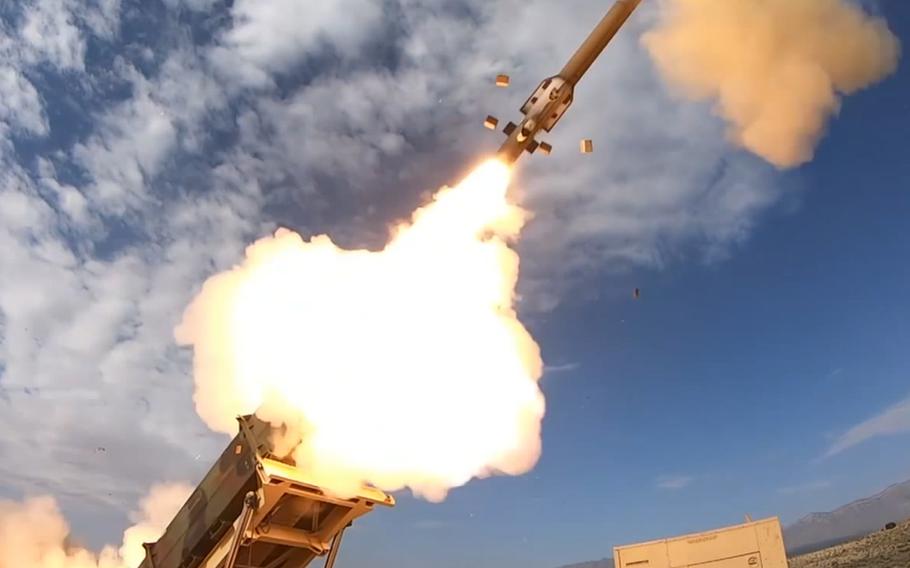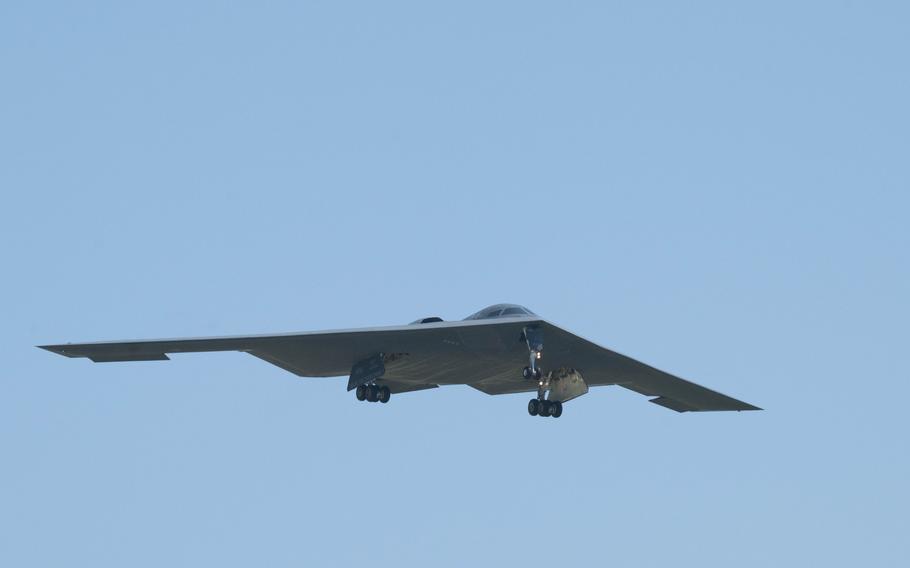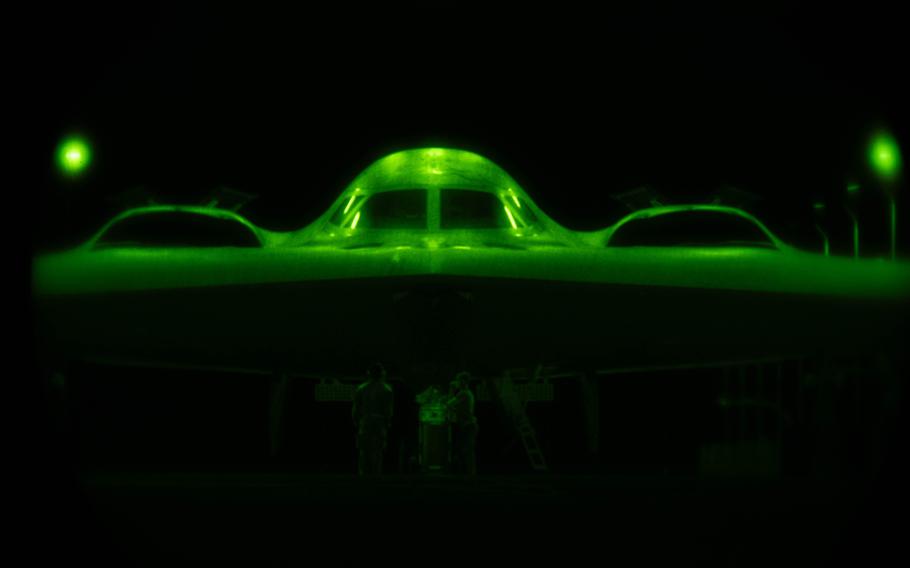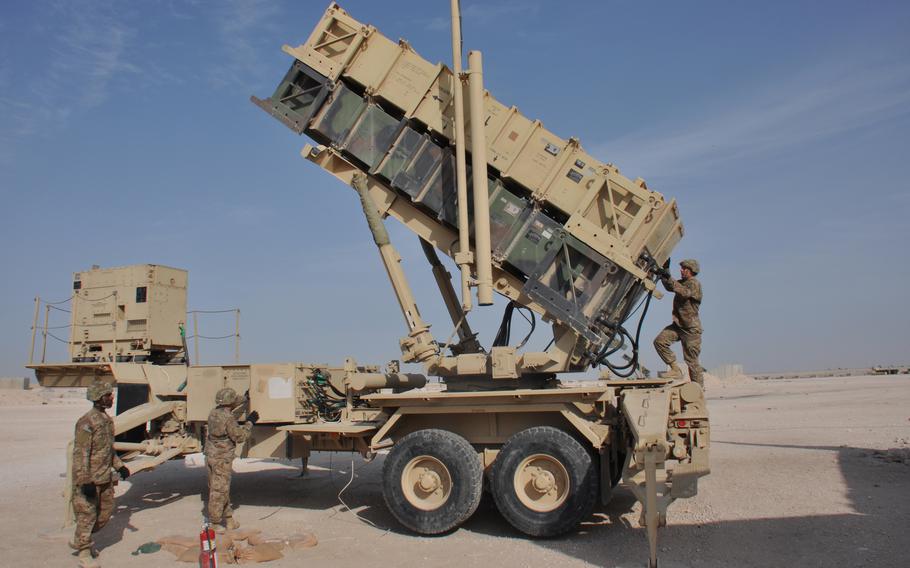
A Patriot Advanced Capability-3 missile is launched during a 2021 test at White Sands Missile Range, N.M.. ( Darrell Ames)
Patriot air defense crews had seconds to fire as a barrage of Iranian missiles headed toward their positions earlier this week at Al Udeid Air Base, the U.S. military installation in Qatar that serves as a command hub for all Middle East operations.
U.S. commanders had ordered an evacuation of the base in anticipation of the blitz launched Monday, which came in response to the American bombardment of the Fordo, Natanz and Isfahan nuclear sites in Iran.
Remaining at Al Udeid were 44 soldiers tasked with preventing the base’s destruction.
“You know that you’re going to have approximately two minutes, 120 seconds, to either succeed or fail,” Joint Chiefs Chairman Gen. Dan Caine said Thursday at the Pentagon.

A screenshot of Joint Chiefs Chairman Gen. Dan Caine at a June 26, 2025, Pentagon press conference as he talks about the June 23 attack by Iran on Al Udeid Air Base in Qatar. (Defense Department)
Caine’s account of the events shed more light on the roles of Air Force B-2 bomber pilots in the Sunday local time attack on the sites and the aftermath at Al Udeid.
Caine also detailed the clandestine campaign to map the terrain of the Fordo underground nuclear site and the push to develop bombs to destroy it.
The initiative started in 2009, when an officer with the Defense Threat Reduction Agency was brought into a vault at an undisclosed location and given a briefing on the massive construction project in the mountains of Iran.
The officer was tasked with studying the facility, and for more than 15 years he and one other teammate “lived and breathed this single target,” Caine said.
The duo studied the geology and watched the Iranians dig it out for years.
“He looked at the vent shaft, the exhaust shaft, the electrical systems, the environmental control systems, every nook, every crater, every piece of equipment going in and every piece of equipment going out,” Caine said. “They literally dreamed about this target at night when they slept.”

A U.S. Air Force B-2 Spirit lands after supporting Operation Midnight Hammer at Whiteman Air Force Base, Mo., June 22, 2025. (U.S. Air Force)
Over time, it became clear that the U.S. military didn’t have a weapon that could penetrate the site.
That sparked an effort to build the Massive Ordnance Penetrator, a 30,000-pound bunker-busting bomb. Years of testing followed.
“And then, on a day in June of 2025, more than 15 years after they started their life’s work, the phone rang and the president of the United States ordered the B-2 force that you’ve supported to go strike and kill this target,” Caine said.
President Donald Trump’s decision to strike in Iran came after weeks of fighting between Tehran and Israel, which initiated an offensive aimed at destroying Iran’s nuclear program.
While Israel took out multiple Iranian military sites and officials connected to the nuclear program, it didn’t have a bomb capable of penetrating the Fordo location.
On June 20, U.S. troops from the active-duty Air Force and the Missouri Air National Guard began preparations to carry out the attack. The crews included male and female aviators whose missions spanned 36 hours in the air.
In the days preceding the attack against Fordo, the Iranians covered the shafts with concrete to try to shield them, Caine said. The concrete cap was forcibly removed when the first 30,000-pound bomb hit, uncovering the main shaft at the site, he said.
“Weapons two, three, four, five were tasked to enter the main shaft, move down into the complex at greater than 1,000 feet per second and explode in the mission space,” Caine said.
The sixth bomb was designed as “a flex weapon” in the event a preceding bomb failed. But all six weapons at each vent at Fordo “went exactly where they were intended to go.” Caine said.
A pilot from a trailing U.S. fighter plane told Caine later that the strike was “the brightest explosion that I’ve ever seen. It literally looked like daylight.”

An Air Force B-2 Spirit is prepared for operations ahead of Operation Midnight Hammer at Whiteman Air Force Base, Mo., in June 2025. (U.S. Air Force)
Since the attack, there has been debate about the extent of the damage done to Iran’s nuclear program. Trump said Iran’s ability to develop a weapon had been obliterated and the program had been set back decades.
On Thursday, the U.N. nuclear watchdog agency said centrifuges buried at the Fordo uranium enrichment plant were no longer operational.
What’s still unclear, however, is what’s become of the country’s stockpile of enriched uranium and whether Iran retains possession of some of it.
After the bunker-busting attack at Fordo, U.S. military bases in the region braced for retaliation.
And on Monday it came.
Among the soldiers on guard at Al Udeid, the oldest was a 28-year-old captain and the youngest a 21-year-old private, Caine said. The Patriot crews had arrived in Qatar from South Korea and Japan to bolster defenses.
As scores of missiles approached the base, the Patriot crews fired to intercept. Caine said he was aware of reports that some of the incoming fire got through, but he suggested that it was debris.
“Between attacking missiles being hit by Patriots, boosters from attacking missiles being hit by Patriots, the Patriots themselves flying around and the debris from those Patriots hitting the ground, there was a lot of metal flying around,” Caine said.
There were no reported injuries connected to Iran’s missiles.
“We believe that this is the largest single Patriot engagement in U.S. military history,” Caine said.

Soldiers from 1-62 Delta Battery Air Defense Artillery Regiment prepare a Patriot missile to fire during an operational readiness exercise at Al Udeid Air Base, Qatar, in 2015. Soldiers used similar equipment to defend the base earlier in the week from an Iranian attack. (James Hodgman/U.S. Air Force)